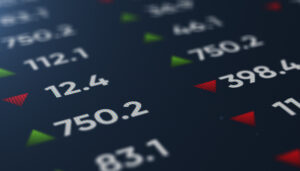

17.03.2022 – The Federal Reserve is raising interest rates for the first time since 2018. And announces six more interest rate steps at once. First it went down. Then stock prices took off. Because the Fed postponed Quantitative Tightening until the next meeting.
Yesterday, there was some confusion – a feast for traders who were on the right side. We always say: Don’t trade around the Fed. First, prices rose on news about the Ukraine war. Then the bulls reacted angrily to the six more interest rate steps for 2022. Finally, the most important message: Jerome Powell postponed the liftoff until later: “The Committee expects to begin reducing its holdings of Treasury securities and agency debt and agency mortgage-backed securities at a coming meeting.” Here is the market reaction in the four-hour chart of the Nasdaq 100.

Source: Bernstein Bank GmbH
An important turnaround: In his address to the Senate Banking Committee a few days ago, Powell had still announced, according to the financial blog “ZeroHedge”, that the Fed would provide clarity on the shrinking of the balance sheet as early as this meeting. The balance sheet total has grown to a good nine trillion dollars. In the event of a reduction in quantitative easing (QE) – i.e. quantitative tightening (QT) – maturing bonds would no longer be fully replaced. Liquidity would thus be withdrawn from the market. The message on QT could therefore have been much stronger. Already, some brokers are showing hope that the Fed will perhaps stop the exit from QE in the event of a new recession. This would provide the stock market with more liquidity again.
US interest rate turnaround
Otherwise, much came about as analysts had expected. The Fed first raised its key interest rate by 0.25 percentage points to a range of 0.25 to 0.5 percent. Meanwhile, the prevailing view is that it will only be 50 points if the central bank wants to cool the stock market down a bit. With six more rate hikes in 2022, the U.S. federal funds rate would be in the 1.75 to 2.0 percent range by year’s end. In December, Fed members were still assuming an average of three rate hikes.
Powell expressed that the likelihood of a recession is not particularly elevated at this time. Some brokers consider this assumption a “policy error” – soon the Fed will have to correct itself here. The Fed also lowered its expectations for U.S. economic growth. Accordingly, the gross domestic product is expected to grow by 2.8 percent – that is 1.2 percentage points less than forecast in December.
Recession versus inflation
The Fed is caught between the mandate to prevent a recession on the one hand. And on the other hand, to stop inflation. Indeed, inflation continues to pick up: Consumer prices had risen to 7.9 percent in February, the fastest pace in 40 years. Scott Minerd of asset manager Guggenheim commented on Bloomberg TV, “I think they are in an inflation panic.”
Our conclusion: once the U.S. slips into recession, the Fed may indeed postpone QT and start new QE. Any statement in this direction is likely to drive rates. On the other hand, stronger-than-planned interest rate moves and a strengthening economy could trigger new interest rate fears – and sharp corrections on the stock market. And then there is the issue of Ukraine. Bernstein Bank keeps an eye on the situation for you!
Important Notes on This Publication:
The content of this publication is for general information purposes only. In this context, it is neither an individual investment recommendation or advice nor an offer to purchase or sell securities or other financial products. The content in question and all the information contained therein do not in any way replace individual investor- or investment-oriented advice. No reliable forecast or indication for the future is possible with respect to any presentation or information on the present or past performance of the relevant underlying assets. All information and data presented in this publication are based on reliable sources. However, Bernstein Bank does not guarantee that the information and data contained in this publication is up-to-date, correct and complete. Securities traded on the financial markets are subject to price fluctuations. A contract for difference (CFD) is also a financial instrument with leverage effect. Against this backdrop, CFD trading involves a high risk up to the point of total loss and may not be suitable for all investors. Therefore, make sure that you have fully understood all the correlating risks. If necessary, ask for independent advice. CFDs are complex instruments and are associated with the high risk of losing money quickly because of the leverage effect. 68% of retail investor accounts lose money trading CFD with this provider. You should consider whether you understand how CFD work and whether you can afford to take the high risk of losing your money.7
